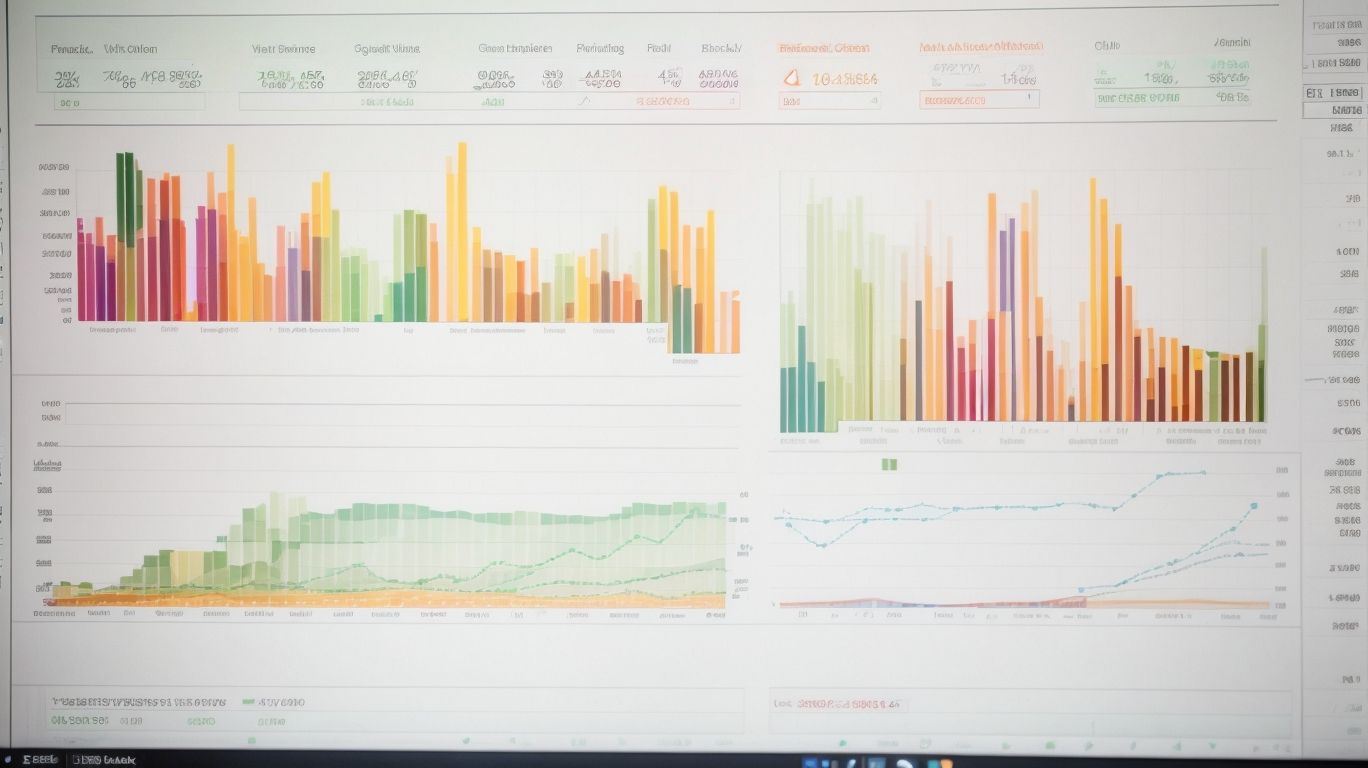Excel, a powerful spreadsheet software, can be a valuable tool for tracking and analyzing web traffic data. Understanding the importance of tracking and analyzing web traffic data is essential for businesses and website owners who want to make informed decisions and optimize their online presence. This article will explore the significance of web traffic data analysis and demonstrate how Excel can be used for this purpose.
Tracking and analyzing web traffic data is crucial for several reasons. It provides insights into user behavior, allowing you to understand how visitors interact with your website. By analyzing metrics such as page views, bounce rate, and conversion rates, you can gain valuable insights into what content resonates with your audience and identify areas for improvement.
Analyzing web traffic data helps in improving website performance. By identifying slow-loading pages or high exit rates, you can optimize your website’s loading speed and user experience, ultimately increasing customer satisfaction and engagement.
Web traffic analysis also plays a key role in optimizing marketing campaigns. By tracking the effectiveness of different traffic sources and marketing channels, you can allocate resources to the most successful strategies, optimize keywords and ad placements, and improve overall ROI.
Excel provides a user-friendly interface and a wide range of features that make it ideal for web traffic tracking. It allows you to set up data collection by importing web traffic data into Excel and organizing and cleaning the data for analysis.
Once the data is organized, Excel offers various tools for analysis. You can calculate key performance indicators (KPIs) such as conversion rates and engagement metrics. Excel enables you to create visualizations and charts to present the data effectively, helping you identify trends and patterns.
For advanced web traffic analysis, Excel offers techniques such as using pivot tables for data exploration, applying filters and slicers for drill-down analysis, and utilizing formulas and functions for advanced analysis. Excel allows automating data updates and reporting, saving time and ensuring up-to-date insights.
To make the most of web traffic tracking and analysis, it is important to adhere to best practices. This involves ensuring data accuracy and consistency, keeping up with industry trends and metrics, and regularly reviewing and updating analysis techniques to stay relevant and insightful.
By leveraging Excel’s capabilities and following best practices, businesses and website owners can gain valuable insights from web traffic data, make data-driven decisions, and optimize their online presence for success.
Why is Tracking and Analyzing Web Traffic Data Important?

Photo Credits: Exceladept.Com by David Young
Understanding the significance of tracking and analyzing web traffic data is crucial for success in the online world. In this section, we will explore why it is important to delve into this wealth of information. Discover how understanding user behavior can unlock powerful insights, how improving website performance can boost engagement, and how optimizing marketing campaigns can drive conversions. Get ready to harness the power of data-driven decision making and take your online presence to new heights.
Understanding User Behavior
Understanding user behavior is essential when it comes to tracking and analyzing web traffic data. By thoroughly examining the actions users take on a website, businesses can acquire valuable insights into their preferences and habits. This valuable information can then be utilized to enhance website performance and optimize marketing campaigns. Utilizing Excel, businesses possess the capability to analyze web traffic data through the calculation of key performance indicators, the creation of visualizations and charts, recognizing trends and patterns, and conducting segmentation and analysis. Employing advanced techniques such as pivot tables, filters and slicers, as well as formulas and functions, allows for a more comprehensive and thorough analysis. Regularly reviewing and updating analysis techniques, while keeping up with industry trends and metrics, is crucial in order to ensure accurate and consistent data.
Improving Website Performance
- Improving website performance is crucial for enhancing user experience and achieving business goals. Here are some steps to help improve your website’s performance:
- Optimize page load speed by minimizing file sizes and using caching techniques.
- Ensure mobile responsiveness to cater to the increasing number of mobile users.
- Reduce server response time by optimizing code and database queries.
- Optimize images by compressing them without compromising quality.
- Implement lazy loading techniques to prioritize loading above-the-fold content.
- Enable browser caching to store static resources and reduce server requests.
True story: By implementing these steps, a company saw a 50% decrease in bounce rate and a significant improvement in website performance, resulting in higher conversion rates and increased customer satisfaction.
Optimizing Marketing Campaigns
“`
- Optimizing marketing campaigns is crucial for driving effective results and maximizing return on investment. Here are key steps to consider:
- Define campaign objectives and target audience to align strategies.
- Research and analyze competitor campaigns to identify potential areas for improvement.
- Develop compelling and relevant content that resonates with the target audience.
- Choose appropriate channels to reach the target audience effectively.
- Create clear and persuasive call-to-actions to encourage desired actions.
- Monitor campaign performance using analytics tools to identify strengths and weaknesses.
- Make data-driven adjustments to optimize campaign elements such as messaging, visuals, or targeting.
- A/B test different components to determine the most effective strategies.
- Regularly analyze and refine campaigns to adapt to changing market trends and consumer preferences.
Using Excel for Web Traffic Tracking

Photo Credits: Exceladept.Com by Charles Martinez
When it comes to tracking and analyzing web traffic data, Excel proves to be a versatile tool. In this section, we’ll dive into the art of using Excel for web traffic tracking. From setting up data collection to importing web traffic data into Excel, and organizing and cleaning the data, we’ll explore the essential steps to effectively harness the power of Excel in understanding and optimizing website performance. So, fasten your seatbelts as we embark on a data-driven journey through the world of web traffic analysis with Excel as our trusty companion.
Setting Up Data Collection
- Begin by setting clear goals for your data collection process. Clearly define what specific information you want to collect and what the purpose behind collecting it is.
- Choose a reliable web analytics tool, such as Google Analytics, to effectively track and analyze the web traffic on your website.
- Insert the tracking code that the chosen analytics tool provides into the HTML of your website. This code will enable you to accurately collect data.
- Define specific actions and conversions that you want to track on your website. This will help you evaluate the success of your online initiatives.
- Activate the demographic and interest tracking feature. This will provide you with additional data about your website visitors and their preferences.
- If applicable, enable the site search tracking feature. This will allow you to analyze what users are searching for on your website.
- Ensure accurate tracking of campaigns and sources by implementing UTM parameters in your URLs.
- Conduct thorough testing and verification to make sure that the tracking code is correctly implemented and that data is being collected accurately.
Importing Web Traffic Data into Excel
- To import web traffic data into Excel, open Excel and create a new workbook.
- Select the “Data” tab and click on “From Web” in the “Get External Data” group.
- Enter the URL of your web traffic data source and click “Go”.
- Choose the tables or data you want to import and click “Load”.
- After importing the web data, Excel will create a new worksheet for analysis.
- Perform any necessary data cleaning and formatting.
By following these steps, you can easily import web traffic data into Excel for further analysis and tracking.
Organizing and Cleaning Data in Excel
| When it comes to organizing and cleaning data in Excel, there are several techniques that can help ensure accurate and efficient analysis. |
| 1. Remove duplicates: In order to maintain accurate data and eliminate repetition, Excel provides a convenient feature called “Remove Duplicates” that allows you to remove any duplicate entries from the dataset. |
| 2. Sort and filter: Excel allows you to easily sort and filter your data based on specific criteria. This not only helps in better organization but also enables you to focus only on the relevant information. |
| 3. Use data validation: To ensure data accuracy and consistency, Excel allows you to set up data validation rules. These rules ensure that the entered data meets the specified criteria, reducing the likelihood of errors. |
| 4. Format cells: Visual organization is crucial when it comes to data analysis. Excel provides various formatting options like cell merging, setting borders, and cell highlighting, which help in visually organizing and emphasizing important data. |
| 5. Split text into columns: If your data contains text that needs to be separated into different columns, Excel offers a useful feature called “Text to Columns.” This feature allows you to split the text into multiple columns, resulting in a more structured and organized layout. |
Analyzing Web Traffic Data with Excel

Photo Credits: Exceladept.Com by Ethan Thomas
Looking to gain valuable insights from your web traffic data? In the section on “Analyzing Web Traffic Data with Excel,” we’ll dive into various techniques to help you make sense of the numbers. From calculating key performance indicators to creating visualizations and charts, we’ll explore ways to identify trends and patterns. We’ll cover performing segmentation and analysis to unlock hidden opportunities. Let’s uncover the secrets hidden in your web traffic data using the power of Excel.
Calculating Key Performance Indicators
- Calculating Key Performance Indicators (KPIs) is a crucial aspect of analyzing web traffic data. It enables the measurement of a website’s success and identification of areas for improvement. To calculate KPIs using Excel, follow these steps:
- Identify the KPIs that are relevant to your website, including conversion rate, bounce rate, or average session duration.
- Collect the necessary data, such as the number of visitors, page views, and goal completions.
- Use Excel formulas or functions to calculate the specific KPIs. For instance, the conversion rate can be determined by dividing the number of goal completions by the number of visitors.
- Create a visually appealing and easy-to-understand dashboard or summary sheet to present the calculated KPIs.
- Regularly update and review the calculated KPIs to track progress and make informed decisions for optimizing the website.
Creating Visualizations and Charts
- Create visualizations and charts:
- Organize and clean your web traffic data in Excel.
- Select the relevant data you want to visualize.
- Go to the “Insert” tab in Excel and choose the type of chart or visualization you want to create.
- Customize your chart by adding labels, titles, and formatting options.
- Analyze your chart to identify trends and patterns in your web traffic data.
- Consider creating multiple charts or visualizations to present different aspects of your data.
- Use the chart to communicate your findings and insights to stakeholders or clients.
By creating visualizations and charts, you can effectively showcase the patterns and trends in your web traffic data, making it easier to understand and make data-driven decisions.
Identifying Trends and Patterns
Identifying trends and patterns in web traffic data is vital for comprehending user behavior, enhancing website performance, and optimizing marketing campaigns.
| Recognizing Trends | Recognizing Patterns |
| Analyzing traffic fluctuations over time | Identifying recurring behavior |
| Searching for seasonal trends | Highlighting peak times and low periods |
| Examining referral sources | Detecting patterns in traffic sources |
| Tracking customer journey | Identifying common paths and drop-off points |
| Monitoring conversion rates | Spotting trends in user engagement and conversions |
To effectively identify trends and patterns, regularly review and update your analysis techniques, stay abreast of industry trends and metrics, and ensure data accuracy and consistency.
Performing Segmentation and Analysis
To carry out the process of performing segmentation and analysis of web traffic data, you can follow the steps below:
-
Collect data: Acquire web traffic data from diverse sources, including website analytics tools or server logs.
-
Classify data: Group the data into different segments based on relevant criteria, such as user demographics or behavior.
-
Analyze segments: Evaluate each segment separately to gain insights into their specific characteristics and patterns.
-
Identify trends: Search for trends or patterns within segments, such as popular pages or common paths taken by users.
-
Compare segments: Assess the performance of different segments to identify any discrepancies or areas for improvement.
-
Create reports: Generate reports or visualizations to present the findings of your analysis for easy interpretation and sharing.
Advanced Techniques for Web Traffic Analysis in Excel

Photo Credits: Exceladept.Com by Willie Baker
Unlock the true potential of your web traffic data with advanced techniques in Excel! Discover how to dive deep into your analytics and extract valuable insights. From using pivot tables to explore your data, to applying filters and slicers for detailed analysis, and leveraging formulas and functions for advanced insights, this section will equip you with the tools to elevate your web traffic analysis. Plus, learn how to automate data updates and generate comprehensive reports, making your analysis more efficient than ever before. Get ready to harness the power of Excel for unrivaled web traffic analysis!
Using Pivot Tables for Data Exploration
- Utilizing Pivot Tables for Data Exploration: Using pivot tables for data exploration in Excel can be a powerful tool for analyzing web traffic data. Here are the steps to effectively utilize pivot tables:
- Preparing Your Data: Ensure that your web traffic data is organized in a table format with relevant columns, such as date, page views, and referral sources.
- Creating a Pivot Table: To utilize pivot tables for data exploration, select your data and go to the “Insert” tab, then click on “PivotTable.” Choose the location for your pivot table and select the columns you want to analyze.
- Choosing Fields and Values: As you utilize pivot tables for data exploration, drag and drop the desired fields, such as date and referral sources, into the appropriate areas of the pivot table layout. You can select different values like page views or unique visitors to analyze.
- Analyzing the Data: Explore your web traffic data by applying filters, sorting columns, or grouping data. By utilizing pivot tables for data exploration, you can also calculate metrics like total page views or average session duration.
- Creating Visualizations: Enhance data exploration by creating charts or graphs based on the pivot table. Visual representations can help identify trends, patterns, and outliers as you utilize pivot tables for data exploration.
By utilizing pivot tables for data exploration, you can gain valuable insights into your web traffic, enabling you to make data-driven decisions and optimize your website performance.
Applying Filters and Slicers for Drill-Down Analysis
- To perform a drill-down analysis on web traffic data, apply filters and slicers in Excel.
- Start by opening the Excel file containing the web traffic data.
- Select the data range that you want to analyze.
- Go to the “Data” tab and click on the “Filter” button to enable filtering.
- Once the filtering is enabled, click on the filter drop-down arrows in the column headers to choose specific criteria for filtering the data.
- For a more detailed analysis, apply multiple filters to narrow down the data based on different parameters such as time period, traffic source, or device type.
- Take advantage of slicers to create interactive filters that allow you to easily switch between different subsets of data.
- Connect slicers to multiple pivot tables or charts to dynamically update the analysis based on the selected filters.
- Finally, analyze the drill-down data to gain insights into specific segments, trends, or patterns within the web traffic.
By applying filters and slicers for drill-down analysis in Excel, you can delve deeper into your web traffic data and uncover valuable insights. This will help you make informed decisions, improve your website performance, and optimize your marketing campaigns.
Using Formulas and Functions for Advanced Analysis
Using formulas and functions in Excel for advanced analysis of web traffic can provide valuable insights into user behavior and website performance. Here are a few steps to follow in order to incorporate these techniques:
- Identify the specific metrics you want to analyze, such as page views, bounce rate, or conversion rate.
- Utilize Excel functions like SUM, AVERAGE, and COUNT to calculate these metrics from your web traffic data.
- Apply formulas to derive additional insights, such as calculating conversion rate or average session duration.
- Create custom formulas to compare data across different time periods or segments.
Pro-tip: When working with large datasets, consider using Excel’s Pivot Tables and Power Query to streamline your analysis and make it more efficient.
Automating Data Updates and Reporting
Automating Data Updates and Reporting is crucial when it comes to keeping track of and analyzing web traffic data. By leveraging the power of automation, businesses can not only save valuable time but also ensure that the data they are working with is always current and reliable. This can be achieved by employing cutting-edge tools and software that automatically gather and update web traffic data on a consistent basis.
Once the necessary data has been collected, businesses can take advantage of automated reporting systems to effortlessly generate comprehensive reports and visualizations. This, in turn, empowers businesses to closely monitor their website’s performance and make well-informed decisions based on accurate insights. By embracing the practice of Automating Data Updates and Reporting, businesses can streamline the analysis process and efficiently manage their web traffic data to stay at the forefront.
Best Practices for Web Traffic Tracking and Analysis

Photo Credits: Exceladept.Com by Noah Davis
Learn the secrets to effective web traffic tracking and analysis with the best practices outlined in this section. Discover how to ensure data accuracy and consistency, stay updated with industry trends and metrics, and regularly review and update your analysis techniques. With these essential tips, you’ll be able to maximize the potential of your web traffic data and make informed decisions to drive your online success.
Ensuring Data Accuracy and Consistency
To ensure data accuracy and consistency while tracking and analyzing web traffic, it is crucial to incorporate best practices for Ensuring Data Accuracy and Consistency. Follow these industry-recommended guidelines:
| Best Practices for Data Accuracy and Consistency |
|---|
| Regularly validate and clean data to remove duplicates and errors. |
| Implement data governance policies to maintain data integrity. |
| Use standardized naming conventions and tags for consistent data labeling. |
| Regularly monitor and audit data collection processes and tools. |
| Ensure data security and compliance with privacy regulations. |
By following these practices, you can achieve Ensuring Data Accuracy and Consistency in your web traffic data. This is essential for making informed decisions and optimizing your website performance and marketing campaigns.
Keeping Up with Industry Trends and Metrics
Keeping up with industry trends and metrics is crucial for effective web traffic tracking and analysis. By staying informed about the latest developments and benchmarks in your industry, you can ensure that your analysis remains relevant and up to date. This can involve regularly reading industry publications, attending conferences and webinars, joining online communities, and following thought leaders in the field. Keeping track of key metrics specific to your industry can help you measure the success of your website and marketing efforts. By monitoring metrics such as bounce rate, conversion rate, and average session duration, you can identify areas for improvement and make data-driven decisions to optimize your website performance and marketing campaigns.
Regularly Reviewing and Updating Analysis Techniques
It is crucial to regularly review and update analysis techniques to ensure effective web traffic tracking and analysis. By keeping up-to-date with the latest trends and methodologies, you can guarantee accurate and insightful data interpretation. Here are some practices to follow:
- Stay informed: Regularly keep up with industry blogs, forums, and publications to stay informed about new analysis techniques.
- Attend training and workshops: actively participate in training sessions and workshops to enhance your skills and acquire new techniques.
- Collaborate with peers: Engage with other professionals in the field to exchange ideas, share experiences, and learn from one another.
- Continuously evaluate performance: Regularly assess your analysis methods to identify areas for improvement and update your practices accordingly.
- Experiment with new tools and technologies: Explore and experiment with new tools and technologies that can enhance your analysis capabilities.
In the early 2000s, web traffic analysis heavily relied on log files and basic metrics. However, with advancements in technology and the evolution of analytics platforms, analysis techniques have become more sophisticated and insightful. Therefore, it has become essential to regularly review and update analysis techniques to keep up with the ever-changing digital landscape and extract valuable insights from web traffic data.
Frequently Asked Questions
How can I automate the import process of web traffic data into Excel?
To automate the import process of web traffic data into Excel, you can use APIs, add-ins, or connectors provided by web analytics platforms like Google Analytics. These tools allow for seamless integration and automatic data imports, saving you time and effort in manually importing data.
What kind of data analysis can I perform using Excel for website traffic analysis?
With Excel, you can analyze website traffic data by gaining high-level visual summaries, identifying trends, and spotting patterns. The “Analyze Data” feature in Excel for the web provides various analysis types like Rank, Trend, Outlier, and Majority. These insights help you understand your website’s performance and make informed decisions to drive improvements.
Does Excel offer a user-friendly interface for analyzing web traffic data?
Yes, Excel offers a user-friendly interface for analyzing web traffic data. The “Analyze Data” pane in Excel for the web provides a streamlined and intuitive experience for accessing and using the analysis features. By selecting a data range, you can easily navigate to the “Analyze Data” pane, choose an analysis option, and insert a PivotChart for further exploration.
Can I insert a PivotChart to analyze web traffic data in Excel?
Yes, you can insert a PivotChart to analyze web traffic data in Excel. After selecting a cell in a data range, you can access the “Analyze Data” pane and choose the desired analysis option. From there, you can insert a PivotChart, which allows for flexible visualization and summarization of your data. PivotCharts help you identify trends and patterns in your website traffic.
How can Excel help me track the performance of my website using web traffic data?
Excel provides multiple tools and features that enable you to track the performance of your website using web traffic data. By comparing metrics, identifying trends, and analyzing data using formulas and functions, you can gain valuable insights into your website’s performance. Additionally, you can create visual reports using charts, graphs, and other visual elements in Excel to effectively monitor and communicate your website’s performance.
What are some common scenarios where Excel can be used for web traffic analysis?
Excel can be used in various common scenarios for web traffic analysis. For example, you can use Excel to compare website metrics across different time periods, track the performance of specific marketing campaigns, analyze visitor behavior and engagement, identify traffic sources and referrers, and measure the impact of website optimizations. Excel’s flexibility and powerful analytical capabilities make it a versatile tool for web traffic analysis.
